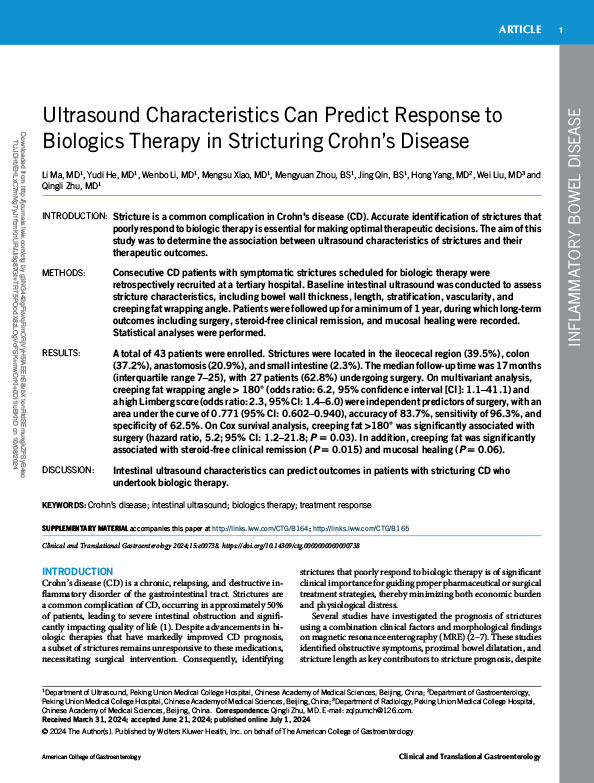Ultrasound Characteristics Can Predict Response to Biologics Therapy in Stricturing Crohn's Disease
August 2024
Clinical and Translational Gastroenterology
Introduction:
Stricture is a common complication in Crohn’s disease (CD). Accurate identification of strictures that poorly respond to biologic therapy is essential for making optimal therapeutic decisions. The aim of this study was to determine the association between ultrasound characteristics of strictures and their therapeutic outcomes.
Methods:
Consecutive CD patients with symptomatic strictures scheduled for biologic therapy were retrospectively recruited at a tertiary hospital. Baseline intestinal ultrasound was conducted to assess stricture characteristics, including bowel wall thickness, length, stratification, vascularity, and creeping fat wrapping angle. Patients were followed up for a minimumof 1 year, during which long-term outcomes including surgery, steroid-free clinical remission, and mucosal healing were recorded. Statistical analyses were performed.
Results:
A total of 43 patients were enrolled. Strictures were located in the ileocecal region (39.5%), colon (37.2%), anastomosis (20.9%), and small intestine (2.3%). The median follow-up time was 17 months (interquartile range 7–25), with 27 patients (62.8%) undergoing surgery. On multivariant analysis, creeping fat wrapping angle > 180° (odds ratio: 6.2, 95% confidence interval [CI]: 1.1–41.1) and a high Limberg score (odds ratio: 2.3,95%CI: 1.4–6.0) were independent predictors of surgery, with an area under the curve of 0.771 (95% CI: 0.602–0.940), accuracy of 83.7%, sensitivity of 96.3%, and specificity of 62.5%. On Cox survival analysis, creeping fat >180° was significantly associated with surgery (hazard ratio, 5.2; 95% CI: 1.2–21.8; P 5 0.03). In addition, creeping fat was significantly associated with steroid-free clinical remission (P 5 0.015) and mucosal healing (P 5 0.06).
Discussion:
Intestinal ultrasound characteristics can predict outcomes in patients with stricturing CD who undertook biologic therapy.

